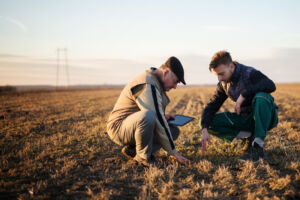Biodiversity and Ecosystem Functions in Southern African Savanna Rangelands: Threats, Impacts and Solutions
Katja Geiβler et al.
Available online
ORYCS investigates the suitability of wildlife management strategies as a climate-friendly land use option. Together with stakeholders, it develops conflict-regulating approaches.
ORYCS explicitly pursues an inter- and transdisciplinary research approach: scientists from the fields of wildlife ecology, vegetation dynamics, hydrogeology and social ecology cooperate with actors at local, regional and national levels, in particular private farmers, communities and public authorities. In its research, ISOE concentrates on the complex motives for action of the stakeholders as well as the existing indigenous and local knowledge and the specific knowledge demands of the various stakeholders. This approach promotes the understanding within the research team of the different perspectives of the stakeholders on the interactions between wildlife management and ecosystem services. In addition, this approach facilitates the development of strategies for appropriate management, including constructive forms of conflict regulation.
The ecosystem of the Namibian savanna is threatened by changing climatic conditions and increasing land use pressure, as can be observed worldwide in semi-arid regions. Traditional land use options based on conventional livestock farming often lead to a deterioration of pastures. Management strategies that take into account the potential of wildlife use, such as meat production and tourism, are usually seen as appropriate approaches to mitigate these negative impacts, as indigenous wildlife are better adapted to local climatic conditions. These strategies are already being pursued in some areas of Namibia, with the use of wildlife proving to be a conflictual challenge for farmers, communities and authorities. Political priorities, economic interests and additional, diverging values can lead to different types of conflicts that require specific and constructive solutions.
This research project “Options for sustainable land use adaptations in savanna systems: Chances and risks of emerging wildlife-based management strategies under regional and global change (ORYCS)” is funded by the Federal Ministry of Education and Research (BMBF) within the funding measure SPACES-II (Science Partnerships for the Assessment of Complex Earth System Processes, 2nd call).
Katja Geiβler et al.
Available online
Robert Lütkemeier et al.
Available online
Morgan Hauptfleisch et al.
Available online
Robert Lütkemeier et al.
Available online
Deike Lüdtke et al.
Available online
What is increasing the pressure on land resources? How can a fair and sustainable use of land resources be achieved?
Go to Topic Page
